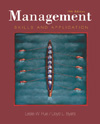 |  Management: Skills and Application, 10/e Leslie W Rue,
Georgia State University - Emeritus
Lloyd L Byars,
Georgia Institute of Technology
Staffing
Chapter Summary| 1. Outline the human resource planning process. Human resource planning (HRP) is the process of "getting the right number of qualified people into the right jobs at the right time." Once organizational plans are made and specific objectives are set, human resource planning attempts to define the human resource needs to meet the organization's objectives.
2. Define job analysis, job description, job specification, and skills inventory. Job analysis is the process of determining, through observation and study, the pertinent information relating to the nature of a specific job. A job description is a written statement that identifies the tasks, duties, activities, and performance results required in a particular job. A job specification is a written statement that identifies the abilities, skills, traits, or attributes necessary for successful performance in a particular job. A skills inventory contains basic information about all employees of the organization.
3. Define equal employment opportunity. Equal employment opportunity refers to the right of all people to work and to advance on the bases of merit, ability, and potential.
4. Describe the recruitment process. Recruitment involves the activities of seeking and attracting a supply of people from which to select qualified candidates for job vacancies.
5. Define affirmative action plan. An affirmative action plan is a written document outlining specific goals and timetables for remedying past discriminatory actions.
6. Discuss reverse discrimination. Reverse discrimination is the provision of alleged preferential treatment for one group (e.g., minority or female) over another group (e.g., white male) rather than merely providing equal opportunity.
7. Define tests, test validity, and test reliability. Tests provide a sample of behavior used to draw inferences about the future behavior or performance of an individual. Test validity refers to the extent to which a test predicts a specific criterion. Test reliability refers to the consistency or reproducibility of the results of a test.
8. Discuss the different types of employment interviews. A structured interview is conducted using a predetermined outline. Unstructured interviews are conducted using no predetermined checklist of questions. In the stress interview, the interviewer assumes a hostile and antagonistic attitude to place the interviewee under stress. In the board (or panel) interview, two or more interviewers conduct the interview. In a group interview, several interviewees are questioned together in a group discussion.
9. Discuss potential problems in the interviewing process. The biggest problem concerns validity and reliability; the interviewer may be legally required to show that the interviewing method used was valid, reliable, and not discriminatory. Second, the interviewer may be favorably or unfavorably impressed with the prospective employee for the wrong reasons and let personal biases enter into his or her judgment of the applicant. Third, the halo effect can cause the interviewer to make judgments based on a dominant favorable characteristic and therefore fail to see the "total" individual. Finally, overgeneralizing can be a problem. The interviewer must remember that the interview is different from the job itself and that the interviewee is likely to be nervous during the interview. |
|



 2003 McGraw-Hill Higher Education
2003 McGraw-Hill Higher Education